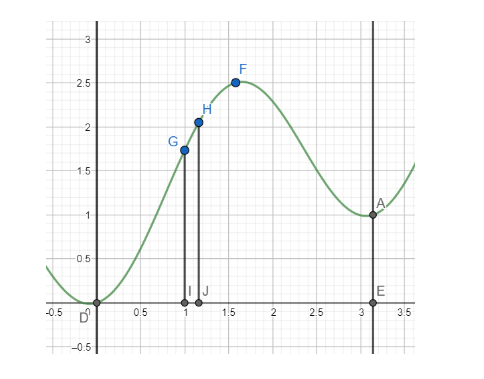
Find the area between the curve $y=\dfrac{x}{\pi }+2{{\sin }^{2}}x$, the x-axis and the ordinates x= 0 and $x=\pi$.
Answer
593.4k+ views
Hint: Use the fact that if $f\left( x \right)\ge 0$ in the interval [a,b] then the area bounded by the curve y=f(x) and the x-axis and the ordinates x = a and x = b is given by $\int_{a}^{b}{f\left( x \right)dx}$. Observe that in the interval $\left[ 0,\pi \right]$, we have $\dfrac{x}{\pi }+2{{\sin }^{2}}x\ge 0$ and hence the area bounded by the curve $y=\dfrac{x}{\pi }+2{{\sin }^{2}}x$, the x-axis and the ordinates x = 0 and $x=\pi $ is given by $\int_{0}^{\pi }{\left( \dfrac{x}{\pi }+2{{\sin }^{2}}x \right)dx}$. Evaluate the integral and hence find the required area.
Complete step-by-step answer:

Consider the vertical strip GHJI
We have GI = y and IJ = dx
Hence the area of the strip is ydx.
The total area will be the sum of the area of the strips between D and E.
Hence, we have
Total area $=\int_{0}^{\pi }{ydx}$
We know that $y=\dfrac{x}{\pi }+2{{\sin }^{2}}x$
Hence, we have
Total area $=\int_{0}^{\pi }{\left( \dfrac{x}{\pi }+2{{\sin }^{2}}x \right)dx}$
We know that $\int_{a}^{b}{\left( f\left( x \right)+g\left( x \right) \right)dx}=\int_{a}^{b}{f\left( x \right)dx}+\int_{a}^{b}{g\left( x \right)dx}$
Hence, we have
Total area $=\int_{0}^{\pi }{\dfrac{x}{\pi }}dx+\int_{0}^{\pi }{2{{\sin }^{2}}xdx}={{I}_{1}}+{{I}_{2}}$, where ${{I}_{1}}=\int_{0}^{\pi }{\dfrac{x}{\pi }dx}$ and ${{I}_{2}}=\int_{0}^{\pi }{2{{\sin }^{2}}x}$
Finding the value of ${{I}_{1}}$:
We have ${{I}_{1}}=\int_{0}^{\pi }{\dfrac{x}{\pi }dx}$
We know that $\int_{a}^{b}{kf\left( x \right)dx}=k\int_{a}^{b}{f\left( x \right)dx}$
Hence, we have
${{I}_{1}}=\dfrac{1}{\pi }\int_{0}^{\pi }{xdx}$
We know that $\int{{{x}^{n}}dx}=\dfrac{{{x}^{n+1}}}{n+1}+C$
Hence, we have
${{I}_{1}}=\dfrac{1}{\pi }\left( \left. \dfrac{{{x}^{2}}}{2} \right|_{0}^{\pi } \right)=\dfrac{1}{\pi }\left( \dfrac{{{\pi }^{2}}}{2} \right)=\dfrac{\pi }{2}$
Hence, we have ${{I}_{1}}=\dfrac{\pi }{2}$
Finding the value of ${{I}_{2}}$:
We have ${{I}_{2}}=\int_{0}^{\pi }{2{{\sin }^{2}}xdx}$
We know that $\int_{a}^{b}{kf\left( x \right)dx}=k\int_{a}^{b}{f\left( x \right)dx}$
Hence, we have
${{I}_{2}}=2\int_{0}^{\pi }{{{\sin }^{2}}xdx}$
We know that if f(x) = f(2a-x), then $\int_{0}^{2a}{f\left( x \right)dx}=2\int_{0}^{a}{f\left( x \right)dx}$
Since ${{\sin }^{2}}\left( \pi -x \right)={{\sin }^{2}}x$, we have
$\int_{0}^{\pi }{{{\sin }^{2}}xdx}=2\int_{0}^{\dfrac{\pi }{2}}{{{\sin }^{2}}xdx}$
Hence, we have
${{I}_{2}}=4\int_{0}^{\dfrac{\pi }{2}}{{{\sin }^{2}}x}\text{ }\left( i \right)$
We know that $\int_{a}^{b}{f\left( x \right)dx}=\int_{a}^{b}{f\left( a+b-x \right)dx}$
Hence, we have
${{I}_{2}}=4\int_{0}^{\dfrac{\pi }{2}}{{{\sin }^{2}}\left( \dfrac{\pi }{2}-x \right)dx}=4\int_{0}^{\dfrac{\pi }{2}}{{{\cos }^{2}}xdx}\text{ }\left( ii \right)$
Adding equation (i) and equation (ii), we get
$2{{I}_{2}}=4\int_{0}^{\dfrac{\pi }{2}}{\left( {{\sin }^{2}}x+{{\cos }^{2}}x \right)dx}$
We know that ${{\sin }^{2}}x+{{\cos }^{2}}x=1$
Hence, we have
$2{{I}_{2}}=4\int_{0}^{\dfrac{\pi }{2}}{1dx}=4\left( \left. x \right|_{0}^{\dfrac{\pi }{2}} \right)=4\times \dfrac{\pi }{2}=2\pi $
Dividing both sides by 2, we get
${{I}_{2}}=\pi $
Hence we have
Total area $=\dfrac{\pi }{2}+\pi =\dfrac{3\pi }{2}$
Note: [1] We can calculate ${{I}_{2}}$ directly using the identity ${{\sin }^{2}}x=\dfrac{1-\cos 2x}{2}$
We have ${{I}_{2}}=2\int_{0}^{\pi }{{{\sin }^{2}}x=2\int_{0}^{\pi }{\dfrac{1-\cos 2x}{2}dx=\int_{0}^{\pi }{\left( 1-\cos 2x \right)dx}}}$
We know that $\int{\cos 2x}dx=\dfrac{\sin 2x}{2}+C$
Hence, we have
${{I}_{2}}=\left. x-\dfrac{\sin 2x}{2} \right|_{0}^{\pi }=\left( \pi -0 \right)-\left( \dfrac{\sin 2\pi }{2}-\dfrac{\sin 0}{2} \right)=\pi $, which is the same as obtained above.
Complete step-by-step answer:

Consider the vertical strip GHJI
We have GI = y and IJ = dx
Hence the area of the strip is ydx.
The total area will be the sum of the area of the strips between D and E.
Hence, we have
Total area $=\int_{0}^{\pi }{ydx}$
We know that $y=\dfrac{x}{\pi }+2{{\sin }^{2}}x$
Hence, we have
Total area $=\int_{0}^{\pi }{\left( \dfrac{x}{\pi }+2{{\sin }^{2}}x \right)dx}$
We know that $\int_{a}^{b}{\left( f\left( x \right)+g\left( x \right) \right)dx}=\int_{a}^{b}{f\left( x \right)dx}+\int_{a}^{b}{g\left( x \right)dx}$
Hence, we have
Total area $=\int_{0}^{\pi }{\dfrac{x}{\pi }}dx+\int_{0}^{\pi }{2{{\sin }^{2}}xdx}={{I}_{1}}+{{I}_{2}}$, where ${{I}_{1}}=\int_{0}^{\pi }{\dfrac{x}{\pi }dx}$ and ${{I}_{2}}=\int_{0}^{\pi }{2{{\sin }^{2}}x}$
Finding the value of ${{I}_{1}}$:
We have ${{I}_{1}}=\int_{0}^{\pi }{\dfrac{x}{\pi }dx}$
We know that $\int_{a}^{b}{kf\left( x \right)dx}=k\int_{a}^{b}{f\left( x \right)dx}$
Hence, we have
${{I}_{1}}=\dfrac{1}{\pi }\int_{0}^{\pi }{xdx}$
We know that $\int{{{x}^{n}}dx}=\dfrac{{{x}^{n+1}}}{n+1}+C$
Hence, we have
${{I}_{1}}=\dfrac{1}{\pi }\left( \left. \dfrac{{{x}^{2}}}{2} \right|_{0}^{\pi } \right)=\dfrac{1}{\pi }\left( \dfrac{{{\pi }^{2}}}{2} \right)=\dfrac{\pi }{2}$
Hence, we have ${{I}_{1}}=\dfrac{\pi }{2}$
Finding the value of ${{I}_{2}}$:
We have ${{I}_{2}}=\int_{0}^{\pi }{2{{\sin }^{2}}xdx}$
We know that $\int_{a}^{b}{kf\left( x \right)dx}=k\int_{a}^{b}{f\left( x \right)dx}$
Hence, we have
${{I}_{2}}=2\int_{0}^{\pi }{{{\sin }^{2}}xdx}$
We know that if f(x) = f(2a-x), then $\int_{0}^{2a}{f\left( x \right)dx}=2\int_{0}^{a}{f\left( x \right)dx}$
Since ${{\sin }^{2}}\left( \pi -x \right)={{\sin }^{2}}x$, we have
$\int_{0}^{\pi }{{{\sin }^{2}}xdx}=2\int_{0}^{\dfrac{\pi }{2}}{{{\sin }^{2}}xdx}$
Hence, we have
${{I}_{2}}=4\int_{0}^{\dfrac{\pi }{2}}{{{\sin }^{2}}x}\text{ }\left( i \right)$
We know that $\int_{a}^{b}{f\left( x \right)dx}=\int_{a}^{b}{f\left( a+b-x \right)dx}$
Hence, we have
${{I}_{2}}=4\int_{0}^{\dfrac{\pi }{2}}{{{\sin }^{2}}\left( \dfrac{\pi }{2}-x \right)dx}=4\int_{0}^{\dfrac{\pi }{2}}{{{\cos }^{2}}xdx}\text{ }\left( ii \right)$
Adding equation (i) and equation (ii), we get
$2{{I}_{2}}=4\int_{0}^{\dfrac{\pi }{2}}{\left( {{\sin }^{2}}x+{{\cos }^{2}}x \right)dx}$
We know that ${{\sin }^{2}}x+{{\cos }^{2}}x=1$
Hence, we have
$2{{I}_{2}}=4\int_{0}^{\dfrac{\pi }{2}}{1dx}=4\left( \left. x \right|_{0}^{\dfrac{\pi }{2}} \right)=4\times \dfrac{\pi }{2}=2\pi $
Dividing both sides by 2, we get
${{I}_{2}}=\pi $
Hence we have
Total area $=\dfrac{\pi }{2}+\pi =\dfrac{3\pi }{2}$
Note: [1] We can calculate ${{I}_{2}}$ directly using the identity ${{\sin }^{2}}x=\dfrac{1-\cos 2x}{2}$
We have ${{I}_{2}}=2\int_{0}^{\pi }{{{\sin }^{2}}x=2\int_{0}^{\pi }{\dfrac{1-\cos 2x}{2}dx=\int_{0}^{\pi }{\left( 1-\cos 2x \right)dx}}}$
We know that $\int{\cos 2x}dx=\dfrac{\sin 2x}{2}+C$
Hence, we have
${{I}_{2}}=\left. x-\dfrac{\sin 2x}{2} \right|_{0}^{\pi }=\left( \pi -0 \right)-\left( \dfrac{\sin 2\pi }{2}-\dfrac{\sin 0}{2} \right)=\pi $, which is the same as obtained above.
Recently Updated Pages
A man running at a speed 5 ms is viewed in the side class 12 physics CBSE

The number of solutions in x in 02pi for which sqrt class 12 maths CBSE

State and explain Hardy Weinbergs Principle class 12 biology CBSE

Write any two methods of preparation of phenol Give class 12 chemistry CBSE

Which of the following statements is wrong a Amnion class 12 biology CBSE

Differentiate between action potential and resting class 12 biology CBSE

Trending doubts
What are the major means of transport Explain each class 12 social science CBSE

Which are the Top 10 Largest Countries of the World?

Draw a labelled sketch of the human eye class 12 physics CBSE

Explain sex determination in humans with line diag class 12 biology CBSE

Explain sex determination in humans with the help of class 12 biology CBSE

Differentiate between homogeneous and heterogeneous class 12 chemistry CBSE




